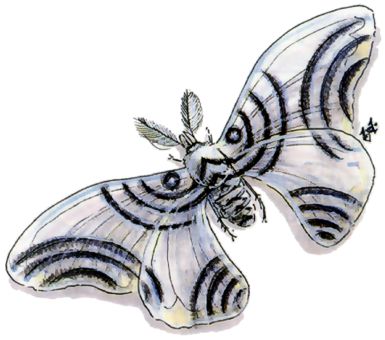

Monstrous Manual

| Moth | Tenebrous Worm | |
|---|---|---|
| Climate/Terrain: | Any, Demi-plane of Shadow | Forests |
| Frequency: | Rare | Uncommon |
| Organization: | Solitary | Solitary |
| Activity Cycle: | Night/Darkness | Any |
| Diet: | Carnivore | Carnivore |
| Intelligence: | Animal (1) | Animal (1) |
| Treasure: | Nil | Nil |
| Alignment: | Neutral | Neutral |
| No. Appearing: | 1 | 1 |
| Armor Class: | 1 | 1 |
| Movement: | 2, Fl 18 (D) | 10 |
| Hit Dice: | 5+1 | 10 |
| THAC0: | 15 | 11 |
| No. of Attacks: | 3 | 1 |
| Damage/Attack: | 1-3/1-3/1-8 | 2-16 |
| Special Attacks: | Pheromone | Acid |
| Special Defenses: | Confusion | Poison Bristles |
| Magic Resistance: | Nil | Nil |
| Size: | M (8’) | M (6’) |
| Morale: | Average (8-10) | Elite (13) |
| XP Value: | 1,400 | 5,000 |
The creature commonly called the gloomwing is the adult stage of the tenebrous worm (see below). These huge moths are native to the demi-plane of Shadow. Their bodies and wings are covered with shimmering, geometric patterns of black and silver. They have large, fern-like black antennae tipped with white and eight legs each ending in a pearly claw.
Combat: A gloomwing’s shimmering markings make it a difficult target. Any creature viewing the moth squarely from above or below must successfully save vs. spells or be confused, as the 4th-level mage spell, for 5-8 (1d4+4) rounds. The markings also provide excellent camouflage, and the moth is 50% undetectable in darkness, twilight, or moonlight. Successfully camouflaged gloomwings cannot cause confusion.
When attacking in darkness or near darkness, a gloomwing receives a -2 bonus to its surprise roll.
Gloomwings normally swoop to the attack. This gives them a + 2 attack bonus and allows them to seize and carry away victims less than 3 feet tall and that weigh less than 61 pounds. Such victims are securely held in the moth’s eight claws while the moth attacks each round with a +4 attack bonus and a +2 bonus to damage. When fighting creatures too large to carry away, the moth hovers, biting and flailing with its two front claws.
During the second and each successive round of combat, the moth emits a potent pheromone that can attract other gloomwings and can cause weakness in any non-insect. The weakness effect has a 25-foot radius and exposed creatures must successfully save vs. poison or lose 1 point of Strength each round they remain in the area of effect. Creatures who are successful with their initial save need not save again if exposure continues. Multiple gloomwings do not require multiple saves. Lost Strength points are recovered at the rate of 1 per turn, beginning 1d4 hours after exposure stops. Creatures reduced to 0 Strength lose consciousness until they regain at least 1 point of Strength. There is a 20% chance each round that an additional 1d4 gloomwings will arrive at the end of any round when one or more gloomwings are emitting this strong scent. If they do arrive, they will join in combating any opponents.
Habitat/Society: Gloomwing moths are short-lived, solitary hunters. They use a variety of pheromones to ward off rivals and to find mates. They form groups, but only to attack large prey, and then only when drawn to the fray by the combat pheromone. When two gloomwings of the same sex meet they flee unless there is combat pheromone in the air.
Ecology: Gloomwing moths live only 4-9 (1d6+3) weeks. During this time they search for mates and eat voraciously. Egg-laden females (½ chance) use corpses of small sized or larger creatures as incubators for their eggs. The eggs hatch in 12 days, sprouting 1d6+4 small tenebrous worms. The corpse cannot be resurrected unless the infestation is removed with a cure disease spell first. Unless killed, the young worms completely devour the body when they emerge.
These natives of the demi-plane of Shadow resemble giant caterpillars. In combat, they strike with powerful mandibles and anyone bitten by the worm must roll a successful saving throw vs. poison, with a -3 penalty, or suffer double damage from the toxic bite. The head and upper body are covered with poisonous bristles that inflict 1d4 points of damage to anyone whose bare skin comes into contact with them. A successful saving throw vs. poison is required to avoid paralysis for 1d4 rounds after contact. At the end of that time, the victim dies unless a neutralize poison or slow poison spell is administered. The chance of attackers being hit by the spines is equal to 10% times their base Armor Class (before shield and Dexterity modifiers). Attacking the worm’s head reduces the chance of contact by 20% (but only one character can attack the head at a time). The mandibles of this worm are attractive and worth from 1,000 to 3,000 gold pieces per set.
